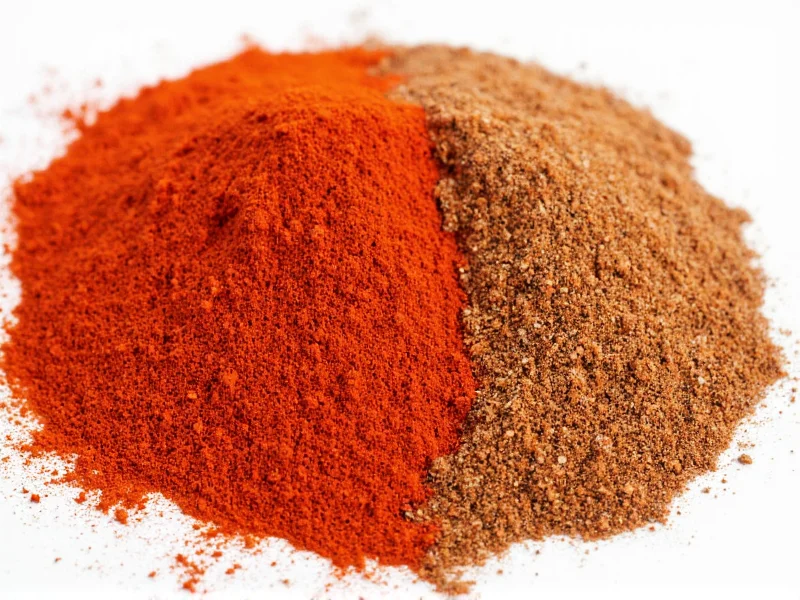Understanding paprika's spice level helps home cooks and professional chefs select the right variety for their culinary creations. Unlike many other spice queries that seek extreme heat measurements, paprika spice level inquiries typically focus on subtle flavor differences rather than intense heat. This comprehensive guide explains the nuanced world of paprika varieties and their heat profiles.
Decoding Paprika Varieties and Their Heat Profiles
Paprika isn't a single uniform spice but rather a spectrum of ground pepper products with varying heat levels. The confusion around paprika spice level stems from the fact that "paprika" refers to both sweet and hot varieties made from different Capsicum annuum peppers. The key to understanding paprika heat levels lies in recognizing regional differences and labeling terminology.
Scoville Scale Context for Paprika Spice Level
When evaluating paprika spice level comparison, the Scoville Heat Unit (SHU) scale provides objective measurement. For reference:
| Spice/Pepper | Scoville Heat Units | Paprika Comparison |
|---|---|---|
| Sweet Bell Pepper | 0 SHU | Base for sweet paprika |
| Sweet Paprika | 0-100 SHU | Mild, no noticeable heat |
| Hot Paprika | 500-1,500 SHU | Moderate warmth |
| Cayenne Pepper | 30,000-50,000 SHU | Significantly hotter than hot paprika |
| Habanero Pepper | 100,000-350,000 SHU | Extremely hot compared to paprika |
Regional Differences in Paprika Spice Level
The geographic origin significantly impacts paprika heat measurement. Understanding these regional distinctions helps answer the common question: is paprika spicy or sweet?
Hungarian Paprika
Hungary produces eight distinct paprika varieties, graded from édesnödéli (sweet) to erős (hot). Traditional Hungarian sweet paprika (like the popular édesnödéli) contains zero heat, while their hot varieties reach up to 1,500 SHU. Hungarian paprika heat level generally stays mild even in hot varieties, focusing more on complex flavor than intense heat.
Spanish Paprika (Pimentón)
Spain's paprika classification emphasizes production method more than heat level. Their three main types include:
- Pimentón Dulce - Sweet variety with no heat (0 SHU)
- Pimentón Agridulce - Bittersweet with minimal heat
- Pimentón Picante - Hot variety reaching 500-1,000 SHU
Spanish paprika often undergoes smoking during production, adding flavor complexity beyond just heat measurement.
American Paprika
In the United States, paprika typically refers to the sweet Hungarian style. Most supermarket paprika registers between 0-100 SHU. Some specialty stores carry hot paprika varieties, but labeling can be inconsistent when determining paprika heat level.
Reading Labels to Determine Paprika Spice Level
When shopping for paprika, these labeling terms indicate heat level:
- Sweet/Mild - Virtually no heat (0-100 SHU)
- Hot/Spicy - Noticeable warmth (500-1,500 SHU)
- Smoked - Refers to production method, not heat level
- Édesnödéli - Hungarian for sweet paprika
- Erős - Hungarian for hot paprika
- Picante - Spanish for hot
Always check for specific heat indicators rather than assuming all paprika has significant spice. Many consumers mistakenly believe paprika spice level is consistently hot, leading to unexpected results in recipes.
Culinary Applications Based on Paprika Heat Measurement
Selecting the right paprika variety transforms dishes:
Sweet Paprika Uses
Sweet paprika (0-100 SHU) works best in:
- Traditional Hungarian goulash
- Deviled eggs
- Rice dishes like paella
- Lightly colored sauces where color matters more than heat
- Meat rubs requiring color without heat
Hot Paprika Uses
Hot paprika (500-1,500 SHU) shines in:
- Spicy chorizo recipes
- Robust stews needing subtle heat
- Meat marinades for grilled dishes
- Recipes specifically calling for hot paprika
Common Misconceptions About Paprika Spice Level
Several myths persist about paprika heat measurement:
- Myth: All paprika is spicy
Reality: Most commercial paprika is sweet with no heat - Myth: Darker paprika is always hotter
Reality: Color relates to ripeness and processing, not heat level - Myth: Paprika provides significant heat like cayenne
Reality: Even hot paprika is 20-30 times milder than cayenne - Myth: Paprika spice level increases with age
Reality: Heat degrades over time; fresh paprika has more consistent heat measurement
Storage Tips for Maintaining Consistent Paprika Heat Level
Paprika's flavor and subtle heat degrade faster than many spices. For optimal paprika spice level consistency:
- Store in an airtight container away from light and heat
- Use within 6-12 months for best flavor and consistent heat measurement
- Buy small quantities from stores with high turnover
- Consider refrigeration in humid climates to preserve volatile compounds
Testing Paprika Heat Level Before Cooking
When uncertain about a paprika's heat measurement:
- Place a small pinch on your tongue
- Wait 15-30 seconds for full effect
- Compare to known references (sweet bell pepper vs. mild chili)
- Adjust recipe quantities accordingly
This practical approach to paprika spice level testing prevents recipe disasters and helps understand subtle differences between brands.











 浙公网安备
33010002000092号
浙公网安备
33010002000092号 浙B2-20120091-4
浙B2-20120091-4